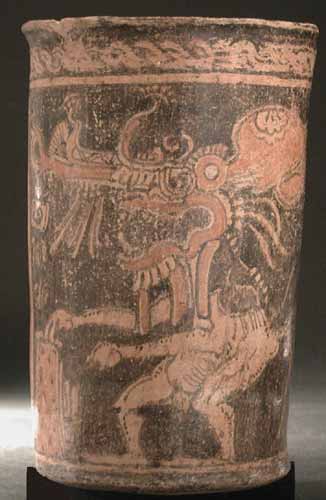Mayan Cylindrical Vessel, 6th Century CE - 9th Century CE
Terracotta
6.5
PF.3602
Further images
The Maya in their great temple cities reached the summit of classical age in Ancient Meso-America. In those temple cities, great artistic expressions such as murals and sculptures flourished. It...
The Maya in their great temple cities reached the summit of classical age in Ancient Meso-America. In those temple cities, great artistic expressions such as murals and sculptures flourished. It is during this classical period in which artists refined their skills to represent the human forms, deities, and other symbolic art works. Used in various rituals and ceremonies, their art embodied rich symbolism, laden with complex meanings that largely remain esoteric. A fine example of the magnificent Mayan sculpture, this polychrome cylindrical vessel depicts a mythical being standing in front of a rectangular structure. Attributed with brown spot-like marks, the structure may symbolize a Mayan jaguar God. The mythical creature is intricately portrayed with details; the lower body has animal features such as large legs, hooves, and a long tail and the head is covered with a headdress representing divine beings and gods. The front legs of the creature are touching the rectangular structure, as if the creature is performing a ritual or communicating with a spirit. Moreover, two columns of hieroglyphics are placed on both sides of the creature. Rendered elaborately in fluid lines, the scene on the vessel successfully portrays motion and gestures. With the top band showing decorative serpent-like motif, this wonderful vessel was most likely used in important rituals and ceremonies. As we wonder about the esoteric contents of the vessel, we learn to appreciate the ancient work of art and the cultural history it brings to us.











